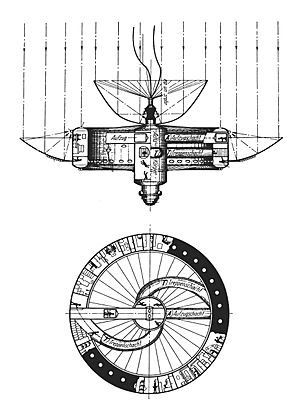Herman Potočnik facts for kids
Quick facts for kids
Herman Potočnik
|
|
|---|---|
 |
|
| Born | 22 December 1892 Pula, Austrian Littoral, Austria-Hungary
|
| Died | 27 August 1929 (aged 36) |
Herman Potočnik (who also used the name Hermann Noordung) was an engineer from Slovenia. He was a pioneer in the field of astronautics, which is the science and art of space travel. He is best known for his ideas about how people could live in space for a long time.
Contents
Early Life and Family
Herman Potočnik was born on December 22, 1892, in the port city of Pula. At that time, Pula was part of the Austro-Hungarian empire. His family was from Slovenia.
Herman's father, Jožef, was a high-ranking navy officer and a doctor. His mother, Minka, came from a family of manufacturers. In 1894, when Herman was only two years old, his father passed away. After this, his mother moved the family to Maribor, another city in Slovenia.
Herman grew up in Maribor with his two brothers, Adolf and Gustav, and his sister, Frančiška. Both of his brothers also became navy officers.
Herman used the pen name "Noordung." The meaning of this name is a bit of a mystery. Some people think it might relate to the German word Ordnung, which means "order." If the "N" means "no," then Noordung could mean "without order."
Education and Military Service
Herman went to primary school in Maribor. Later, he attended military secondary schools. His uncle, who was a major-general in the army, likely helped him get into these schools.
From 1910 to 1913, Herman studied at the Imperial and Royal Technical Military Academy near Vienna. He graduated as an engineer and specialized in building railways and bridges.
During World War I, he served in different areas. In 1915, he was promoted to First Lieutenant. In 1919, he had to leave the military because he became very sick with tuberculosis. He was a captain when he left.
After leaving the army, Herman studied electrical engineering at the Vienna University of Technology. From 1925 onwards, he focused all his time on rocket science and space technology. Because of his ongoing illness, he lived with his brother Adolf and did not marry or find a regular job.
His Famous Book: The Problem of Space Travel

(Legend: Achs-Körper: axle body. Aufzugschacht: elevator shaft. K: electric cable to an external observatory. Kondensatorrohre: condenser pipes. S: airlock. Treppenschacht: stairwell. Verdampfungsrohr: boiler pipe).
In late 1928, Herman Potočnik published his only book, called Das Problem der Befahrung des Weltraums - der Raketen-Motor. This translates to The Problem of Space Travel - The Rocket Motor. The publisher put the year 1929 on the book, so it is often mistakenly thought to have been published then.
In this book, which had 188 pages and 100 hand-drawn pictures, Potočnik shared his detailed plan for reaching space and having people live there permanently. He designed a space station in great detail. Many historians of spaceflight believe this was the first time someone truly designed architecture for space.
He also wrote about how orbiting spacecraft could be used to observe the ground, both for peaceful reasons and for military ones. He also explained how the special conditions of space could be useful for scientific experiments. Potočnik was worried about these new discoveries being used for destructive military purposes.
His book was translated into Russian in 1935 and into English in 1995 by NASA. Parts of it were even translated into English as early as 1929 for an American magazine called Science Wonder Stories.
Potočnik's many ideas made him one of the important founders of astronautics. His ideas were first taken seriously by amateur rocket enthusiasts in Germany. Later, his book might have also influenced Sergey Korolev, a key figure in the Soviet space program.
Potočnik's book also talked about geostationary satellites, which stay in the same spot above Earth. He discussed how they could communicate with the ground using radio. His wheel-shaped space station design later inspired Wernher von Braun, another famous rocket scientist, in 1952. Von Braun saw orbiting space stations as a necessary step for traveling to other planets. In the 1968 movie 2001: A Space Odyssey, a space station similar to Potočnik's design was shown.
Death
Herman Potočnik died on August 27, 1929, in Vienna, Austria. He was only 36 years old and passed away from pneumonia. He was buried in Vienna. A newspaper in Maribor printed a short notice about his death, mentioning his military ranks and illness, but not his important work on space travel.
His Legacy
Even though he died young and in poverty, Herman Potočnik left a lasting impact:
- Streets in cities like Graz, Ljubljana, and Pula are named after him.
- In the late 1990s, there was a suggestion to name the International Space Station after him, but it was not chosen.
- In 1999, a special meeting was held at the University of Maribor to celebrate his life and work, marking 70 years since his book was first printed.
- An asteroid discovered in 1999, called 19612 Noordung, is named after him.
- In 2006, the Herman Potočnik Noordung Memorial Centre (HPNMC) was built in Vitanje, Slovenia.
- In 2012, the Cultural Centre of European Space Technologies (KSEVT), inspired by his work, was also built in Vitanje.
See also
 In Spanish: Herman Potočnik para niños
In Spanish: Herman Potočnik para niños


